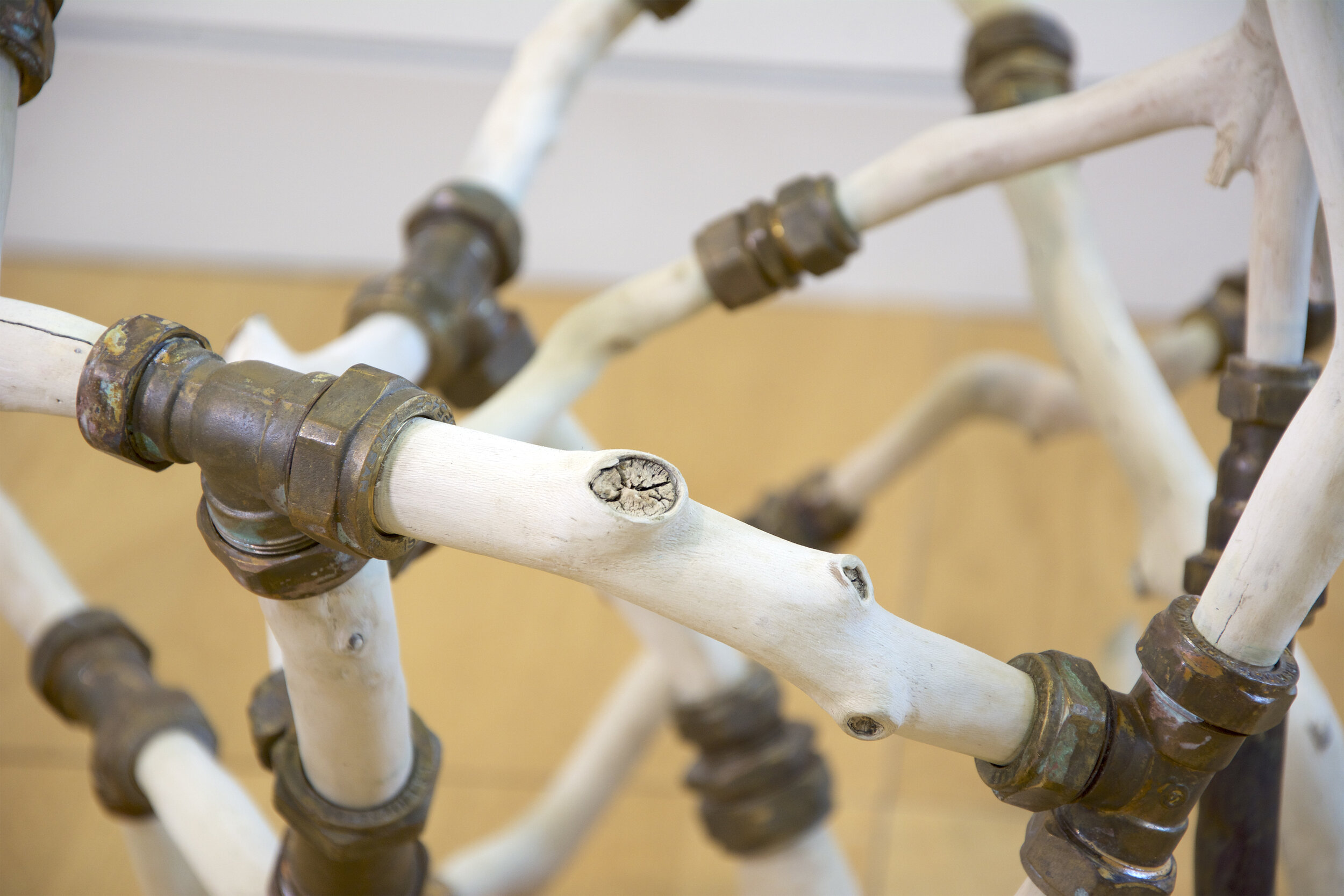Sankey Artist Statement
Working primarily in sculpture and installation Katherine Sankey’s artworks deal with the fragile intersections of body, environment, and infrastructure— how planetary and human constructed systems connect with and impact our own anatomies and psychologies. Sankey’s process grapples with decolonising and re-territorializing matter and signification – researching both physically and through diving into the discourses of such thinkers as Karen Barad, Kathryn Yusoff and Lynn Margulis. Interrogating the position of humans on the planet through a geo-queering discourse, Katherine Sankey’s artworks occupy a liminal space between decay and adaptation – dynamically ‘inhabiting’ the exhibition environment - they navigate disturbance, repair, and multi-species resistance.
PET detail, Luan Gallery, Athlone, Ireland 2018, private collection. Photo: John Owens
KATHERINE SANKEY CV
born in Paris, lives in Dublin and is North of Ireland/settler-Australian,
Solo Exhibitions (and duo)
2025 Forest of Single Breaths, Dublin Gallery Weekend, College Lane Gallery Howth,
Curator Jobst Graeve
2024 PETRICHOR | smelling the rain, with Anna Macleod, STAC Clonmel, Ireland,
Curator Helena Tobin
2023 EarthLab: living matters, RHA Gallery Dublin, Ireland
an atom bomb in each morsel of life, The LAB Gallery Dublin, Ireland
SANKEY | WALKER, The DOCK Carrick-on-Shannon, Ireland, with Corban Walker,
Curator Sarah Searson
2021 HYDROZOMES | waterbodies, PALLAS Projects Gallery, Dublin, Ireland
2020/21 Containment: Chthonic Parts II & III, RUA RED, Tallaght, Dublin, Ireland
2014 Organelle (studio show), Distillery Court, Dublin, Ireland
2007 Zones of Proximity, The SHED, Foley St, Dublin, Ireland
1993 BREATH, Galeria Pryzmat, Krakow, Poland
Beginning Backwards, Chopin Museum Gallery, Grodkow, Poland
Everyday Gravities, install-action, Galeria Impart, BWA, Wroclaw, Poland
Corrosion of Sense, install-action at Galeria Entropia, Wroclaw, Poland
What Matters What Margins? Install-action at Galeria X, Wroclaw, Poland
Brododactylos, Galeria Labyrynt 2, BWA Lublin, Poland
1992 Mephisto’s Epilogue live performance, Lublin Television, Poland
Further Forth - Firth of Forth, Richard Demarco Gallery, Edinburgh, Scotland
1990 Polar-switch, Rondeau Gallery, Sydney, Australia
1989 Another Axis, Pan Sydney ’89, W.I.N.D.O.W. Gallery, Sydney, Australia
Group Exhibitions
2026 SUBSTRATA, The Substation Dublin Port, 5Lamps Festival, 3 person, Curator Claire Halpin
2025 Still We Gather, Galway Arts Centre, until Feb 2026
This Too WIll Pass, Galway Arts Festival at Interface, Inagh, Connemara,
Curator Valeria Ceregini
Connections, Cross-border exhibition Office of Public Works, Curator Jacquie Moore
Creative Convergence, The Curve, Temple Bar, Curator Valeria Ceregini
RHA Annual Exhibition, Dublin
2024-5 Future Fragilities, (4 person), Turin Art Week, Palazzo Birago, Italy, Curator Valeria Ceregini
Thresholds to the Unseen, Solstice Arts Centre, Navan, Curator Brenda McParland,
DISTINCT, Disability and Climate Change, Project Art Centre, Dublin,
Curator AlanJames Burns
Invited Artist, 194th RHA Annual Exhibition, Dublin
2023/4 Maslow’s Hammer, Periodic Review, PALLAS P/S, Dublin, Ireland
2021 Woman in the Machine, VISUAL, Carlow
PALIMPSEST with @5lampsarts, CHQ, IFSC, Dublin
PLATFORM 21, ‘Worlds of Their Own’, Draíocht Gallery, Blanchardstown
191st RHA Annual Exhibition, Dublin
2020 Invited Artist, 190th RHA Annual Exhibition, Dublin
ROOT Exhibition, Leitrim Organic Centre and Online
Kunsthal Charlottenborg Spring Exhibition, Copenhagen, Denmark
2019 RUA RED Winter Open, Tallaght, Ireland
Tactical Magic, TULCA Festival of Visual Art, Galway, Ireland
RHA Annual Exhibition, Dublin, Ireland
2018 CAST, Luan Gallery, Athlone, Ireland
2008-09 Sculpture in Context, National Botanic Gardens, Dublin, Ireland
RHA Annual Exhibition, Dublin, Ireland
Ni Hao-Dia Duit, Cross-cultural Project by Jay KOE, IMMA Studios, Dublin, Ireland
2006 Initiation of Moore Street Lending Library Project, Fire Station Artist Studios, Moore St Dublin.
2005 Latitude Longitude Season, Catalyst Arts Gallery, Belfast, Ireland
2002 Crossings, Australian Aboriginal & European Artist Exchange, COLLECTIF 12,
Maningrida, Northern Territory, Australia
2001 Crossings, COLLECTIF 12, Paris, France
1997 Downside Collection Exhibition, Julian Barran Gallery Ltd, London, England
@re we close? Galerie Artsenal, Paris, France
1993 Bloomsday, La Centre Culturel Irlandaise, Paris, France
Lingua Franca Sculpture Symposium, BWA Galleries, Wroclaw and Czestochowa, Poland
1992 The Unofficial Supplement to Bruno Schulz, The University of Katowice, Cieszyn, Poland
M.o.M.I.A., Jerzy Grotowski Centre, Wroclaw, Poland
Pentagonale Plus, Exhibition of New European Art, Knights Park Gallery, Richard Demarco,
London, England
1990 Aerial Art - Cathedral of the Industrial Trapeze, The Foundry Galleries, Sydney, Australia
Seriously Fruit Exhibition, Rondeau Gallery, Sydney, Australia
1989 White-Wash Show, Rondeau Gallery, Sydney, Australia
The Production of Optical Equivalences, Exhibition of Australian Satirical Art, EMR Gallery,
Sydney, Australia
Bursaries/Awards/Prizes
2025 Prize for Best Sculpture in any medium, RHA Annual Exhibition, from Solomon Gallery
2021/2024 Award - Arts Council of Ireland Agility Award
2022/2021 Bursary - Arts Council of Ireland Visual Art Bursary
2020 Bursary - Fire Station Artists’ Studios Sculpture Award Bursary
Bursary Dublin City Council Visual Art Bursary
2019 Award- RUA RED Winter Open - Solo Exhibition Award for 2020/21
2002 Travel Bursary – Arts Council of Ireland
1992 Bursary BWA Galleries Exhibitions Bursary, Poland
Lectures/ Residencies/Workshops
2025 Talk - Pallas Projects/Studios, Entangled Life series, curator Cristina Nicotra
2024 Residency & Talk- STAC Clonmel, collaboration with Anna Macleod on
PETRICHOR | smelling the rain
Talk and Workshop - Solstice Arts Centre as part of Thresholds to the Unseen
2023 Talk - The Dock Carrick-on-Shannon with Corban Walker as part of SANKEY | WALKER
Talk - The Lab Gallery, as part of an atom bomb in each morsel of life
Talks and Ceramic Demonstration RHA Gallery during EarthLab: living matters
& RHA ‘Making Festival’
2022 Lecture - Culture Night, Lecture, Fire Station Artists’ Studios, Dublin, Ireland
2021 Lecture - National College of Art and Design, Dublin, Ireland
Residency - Fingal County Council Draíocht AIR Residency, Fingal County Council,
2020 Lecture - Royal Hibernian Academy ‘Plinth Politics’, Dublin, Ireland
2004/5 Residency and workshops series- Larkin Community College: ‘The Curriculum through Art’.
1993/4 Residency - Downside Abbey School, Bath, England
1992/3 Residency - Galleria ‘X’ Wroclaw, Poland
Residency – Ośrodek Grotowskiego, Grotowski Centre, Wroclaw, Poland
1992 Residency - Richard Demarco Gallery, Edinburgh, Scotland
Education
1994-7 DEA (pre-doc), Art & Psychoanalytic-based Literary Theory, Hélène CIXOUS,
Centre D’Etudes Feminines, Université Paris VIII, France
1990-1 PG Dip. Theatre Design, Trent University, Nottingham, England
1986-9 BA Visual Art (sculpture), Sydney College of the Arts, Australia
Public Collections:
2025, Visual Artists Ireland, 2023, Office of Public Works, Dublin Castle, 2021 Arts Council of Ireland
